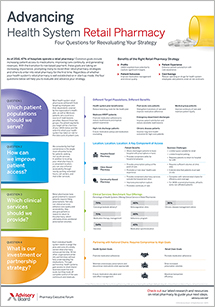Auto logout in seconds.
Continue LogoutThis month, Amazon launched its highly anticipated online pharmacy that allows customers to order prescription drugs to their homes. This move is really a test of people's trust in Amazon's brand. If people decide to trust Amazon with their prescriptions, then this likely opens the door for Amazon to make bigger moves in the health care space. If people decide to stick with their local pharmacies, then we'll see limited impact.
Who are the innovative disruptors in care delivery?
About 'Amazon Pharmacy'
The new online store called "Amazon Pharmacy" is available in all states except Hawaii, Illinois, Kentucky, Louisiana, and Minnesota. Prescriptions will be delivered in discreet packaging, and Prime members will be able to receive free two-day delivery on their prescription orders.
Amazon said its new pharmacy enables customers to complete the "entire pharmacy transaction on their desktop or mobile device through the Amazon App," which will now feature a secure pharmacy profile where users can enter their health insurance information and payment options, as well as manage their prescriptions.
The interface allows users to look up their medications, as well as other available brand name and generic versions. Amazon Pharmacy will only accept prescriptions written by a licensed health care provider, and it will not deliver Schedule II controlled drugs, including most opioids. Amazon Pharmacy will also staff pharmacists 24/7 to answer questions about medications over the phone.
Amazon Pharmacy will accept most insurance, and will allow users to compare the price of medication purchased with insurance, without insurance, or a cash-pay discount available for Prime members. Amazon is offering Prime users who pay without insurance an up to 80% discount on generic drugs and an up to 40% discount on brand-name drugs. Amazon said those discounts will also be available at over 50,000 participating pharmacies nationwide.
What 'Amazon Pharmacy' means for the pharmacy industry
Amazon's launch of Amazon Pharmacy is by far the company's biggest step into the health care industry. But it's not a guaranteed win for the company: Mail-order pharmacy has struggled to take off in the past, despite many pharmacy benefit managers touting the convenience and incentivizing its use with lower copays. That said, if anyone can shift consumer preferences, it might just be Amazon.
Prime customers seem to be pretty happy customers. According to one estimate, Amazon has 126 million Prime members, and 93% of members renew after their first year (this number jumps to 98% after the second year of Prime membership). Amazon's core competency of the "frictionless transaction," resonates with consumers. If they can replicate this ease of use for pharmacy transactions, I suspect patients will be willing to give them the benefit of the doubt.
If Amazon pharmacy does succeed, here's how we might see it change the pharmacy business as we know it:
- In the near term, we'd expect Amazon to shave a small percentage of prescriptions from pharmacies across the country. These may be among the more profitable prescriptions filled by a typical pharmacy, as they're likely for refillable maintenance medications (first fills take more pharmacy resources to fill than refills). In addition, Amazon may take a larger portion of profitable cash-pay patients, especially in situations where patients prefer a brand medication to a PBM-required generic. Given that they're taking more profitable patients, even if Amazon takes only a small portion of customers from pharmacies across the country, that may be enough to threaten the sustainability of small, independent pharmacies.
- In the intermediate term, Amazon's move may further hasten the co-locating of pharmacy and medical services. The largest pharmacy chains—CVS Health, Walgreens, and Walmart—are already pushing forward on this type of integration. However, provider organizations may also need to think about how patients will receive their time-sensitive prescriptions and whether to build out pharmacy services if local pharmacies are less available.
- In the longer term, strong customer satisfaction could create the momentum needed for Amazon to disrupt more of the established pharmacy benefits business, such as by gaining access to narrow PBM specialty pharmacy networks, or even circumventing pharmacy benefit managers altogether with new models for managing drug costs.
But again, Amazon faces some big hurdles in overcoming consumer hesitancy to mail-order pharmacy. As Amazon Pharmacy ramps up, these are the three questions we'll be asking to measure success:
- Will complex patients with multiple chronic medications steer away from Amazon pharmacy as they have other mail-order-pharmacies?
- Will Amazon pharmacy have the infrastructure required to manage real-time prescriber interactions related to refills, medication changes, and other patient care concerns?
- Will Amazon be able to virtually manage complex payment scenarios, such as those involving prior authorizations and copay cards, or will those transactions stay with local pharmacies?

Patient access, care continuity, and revenue goals are more important than ever, and as a result, many hospitals are entering retail pharmacy for the first time or revisiting their retail pharmacy strategies.
Here's how to evaluate and advance your strategy, whether it's new or established.
Don't miss out on the latest Advisory Board insights
Create your free account to access 1 resource, including the latest research and webinars.
Want access without creating an account?
You have 1 free members-only resource remaining this month.
1 free members-only resources remaining
1 free members-only resources remaining
You've reached your limit of free insights
Become a member to access all of Advisory Board's resources, events, and experts
Never miss out on the latest innovative health care content tailored to you.
Benefits include:
You've reached your limit of free insights
Become a member to access all of Advisory Board's resources, events, and experts
Never miss out on the latest innovative health care content tailored to you.
Benefits include:
This content is available through your Curated Research partnership with Advisory Board. Click on ‘view this resource’ to read the full piece
Email ask@advisory.com to learn more
Click on ‘Become a Member’ to learn about the benefits of a Full-Access partnership with Advisory Board
Never miss out on the latest innovative health care content tailored to you.
Benefits Include:
This is for members only. Learn more.
Click on ‘Become a Member’ to learn about the benefits of a Full-Access partnership with Advisory Board
Never miss out on the latest innovative health care content tailored to you.

